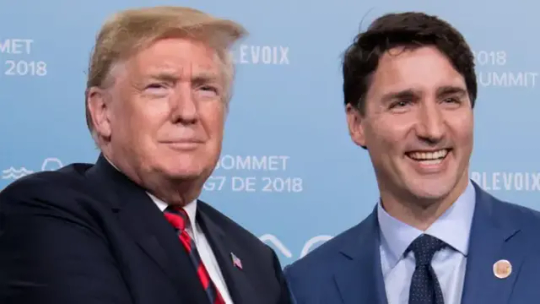#cusma
Explore tagged Tumblr posts
Text
Why Cusma will not stop the tariffs if Trump wants them to happen | CBC news
Canadian leaders have spent weeks fighting to avoid a threat to the president of the United States, Donald Trump, to impose 25 percent tariffs on the goods that direct the side of the state from this side of the border. The American leader repeated that threat in Thursday afternoon, only two days before the date of February 1, his administration suggested that tariffs could be implemented. In the…
0 notes
Text
Amid Trump Trade Worries, China Tariffs Give Canada ‘Firm’ Ground: Freeland

Amid Trump Trade Worries, China Tariffs Give Canada ‘Firm’ Ground: Freeland As Donald Trump prepares for his return to the Oval Office in 2025, Canadian Deputy Prime Minister and Finance Minister Chrystia Freeland is positioning Canada to navigate the impending trade landscape. Following the first meeting of the newly revived cabinet committee on Canada-U.S. relations, Freeland emphasized the importance of a unified stance toward China as a foundation for upcoming negotiations with the United States. Trade Relations Under Trump Freeland’s remarks come in the wake of Trump’s victory in the 2024 U.S. presidential election, during which he pledged to implement blanket tariffs on all goods entering the country. This includes intentions to renegotiate the Canada-United States-Mexico Agreement (CUSMA), which was established during his first term. The news of Trump’s return has sparked concern among leaders in Canada’s steel and aluminum sectors, recalling the 25% tariffs on Canadian steel and 10% tariffs on aluminum imposed during Trump’s first administration. These tariffs prompted Canada to retaliate with its own measures against U.S. goods. Lessons Learned Freeland noted that Canada has learned valuable lessons from its prior negotiations with Trump. “What’s important about that whole experience is that Canada and the United States agreed, at the end of the day, that it didn’t make sense for our two countries to have those tariffs imposed,” she stated. This agreement highlights the economic interdependence between the two nations. She also pointed out recent collaborative efforts between Canada and the U.S. to impose tariffs on Chinese steel, aluminum, and electric vehicles, positioning both countries as a united front against China. Freeland expressed confidence that this alignment would strengthen Canada’s standing as a reliable trading partner. Diplomatic Relations David MacNaughton, Canada’s former ambassador to the U.S., echoed Freeland’s sentiments, emphasizing the importance of being in sync with American officials regarding China. He warned that any divergence in trade policy could lead to significant challenges for Canada. Brian Kingston, president of the Canadian Vehicle Manufacturers Association, added that Canada has the potential to secure exemptions from Trump’s tariffs by becoming a preferred supplier of critical minerals as the U.S. seeks to reduce its reliance on China. He suggested that if Canada enhances its mining capacity, it could emerge in a stronger position under a Trump administration. Addressing Trade Challenges Freeland, who met with Canadian steel producers in Hamilton, Ontario, acknowledged the ongoing challenges in trade, particularly concerning circumvention tactics that allow exporters to bypass tariffs by routing goods through friendly countries. When asked if she was the right person to negotiate with Trump in a second term, Freeland confidently asserted her readiness to face renewed pressures. She highlighted her established relationship with Robert Lighthizer, Trump’s former trade czar, who is expected to play a significant role in the upcoming administration. “In my experience, President Trump respects strength and he respects people and countries who are strong and clear in defending their national interests,” Freeland stated. “That’s what I’ve always done, and that’s what I will continue to do.” Conclusion As Canada braces for the implications of Trump’s return, Freeland’s strategic focus on a unified front against China and her readiness to negotiate with the incoming administration may prove crucial. With potential tariff challenges on the horizon, Canada aims to leverage its position to foster stronger trade relations while navigating the complexities of U.S. policy under a familiar leader. Thank you for taking the time to read this article! Your thoughts and feedback are incredibly valuable to me. What do you think about the topics discussed? Please share your insights in the comments section below, as your input helps me create even better content. I’m also eager to hear your stories! If you have a special experience, a unique story, or interesting anecdotes from your life or surroundings, please send them to me at [email protected]. Your stories could inspire others and add depth to our discussions. If you enjoyed this post and want to stay updated with more informative and engaging articles, don’t forget to hit the subscribe button! I’m committed to bringing you the latest insights and trends, so stay tuned for upcoming posts. Wishing you a wonderful day ahead, and I look forward to connecting with you in the comments and reading your stories! Read the full article
0 notes
Text
The Law Bytes Podcast, Episode 210: Meredith Lilly on the Trade Risks Behind Canada’s Digital Services Tax and Mandated Streaming Payments
The battle over a digital services tax has been the subject of Law Bytes podcast episodes for several years as the Canadian government signalled its intent to move ahead with one even as US officials warned of risks of trade retaliation if they did so outside of an international framework. With the DST now in effect, what does trade law have to say and how might the US respond? Meredith Lilly is…
0 notes
Text
Citizenship Matters: How The Lives Of "Free Trade Professionals", Americans Abroad And Casablanca Overlap
Mexico City – September 2023 – A reminder that citizenship matters Last month I attended an Immigration Conference in Mexico City. It was organized by Buffalo immigration lawyer Joe Grasmick and focussed on the USMCA, CUSMA (formerly called the NAFTA Free Trade Immigration Visa- TN Visa). The conference highlighted the opportunities available to citizens of Canada, Mexico and the USA to live in…
View On WordPress
0 notes
Text
🇨🇦 Dreaming of working in Canada? You will need to apply for work permit to get authorization to work in Canada. 🇨🇦 Check out available work permits options in Canada; from permits needing LMIA to LMIA-exempt to Global Talent Stream👇
#Canadian work permit#CUSMA work permit#Entrepreneur work permit#express entry#Global Talent Stream#International Mobility Program#Intra-company transfer#Labour Market Impact Assessment (LMIA)#Post-Graduation Work Permit (PGWP)#Quebec CAQ#Self-employed work permit#Tech worker Canada#Temporary Foreign Worker Program#TV and film work permit#Work in Canada
0 notes
Text
Canada halts second counter-tariffs on $125 billion worth of US goods after Trump's pause - The Times of India
US President Donald Trump and Canadian PM Justin Trudeau (File Image) The Canadian government has delayed its second set of retaliatory measures against US tariffs by one week, following President Donald Trump’s decision to postpone levies on most Canadian and Mexican goods for a month.“As a result, Canada will not proceed with the second wave of tariffs on $125B of US products until April 2nd,…
#Canada counter-tariffs on US goods#Canada retaliatory tariffs#CUSMA tariff exemptions#Trump halts tariffs on Canada#US tariffs on Canadian products
0 notes
Text
#EspacioAtemporal
🖼 “HUELLAS” 📜✒📷🎨🖌️👀
💥 Exposición colectiva que celebra el arte figurativo e indaga en las marcas —físicas, emocionales y simbólicas— dejadas por el ser humano en su tránsito por el mundo. A través de la pintura contemporánea, la muestra explora cómo el cuerpo, la memoria y la experiencia social se entrelazan para construir identidades, visibilizar ausencias y desafiar narrativas dominantes, con especial énfasis en las perspectivas de género, la disidencia y lo marginal.

☀️ Las obras seleccionadas dialogan con la huella como metáfora abierta: desde la impronta física hasta las cicatrices del tiempo, lo que se borra y lo que persiste. ¿Qué queda de nosotrxs cuando el cuerpo se desvanece, pero su rastro permanece? ¿Cómo se inscribe lo femenino, lo racializado en un relato histórico que ha oscilado entre el borrado y la fetichización?👩



🤭 Asi, la muestra cuestiona los límites de la representación, invitando a reflexionar sobre la fragilidad, la resistencia y la permanencia en un mundo en fuga, y se convierte en un palimpsesto de existencias donde cada obra desvela capas donde lo íntimo se hace colectivo, lo efímero se fossiliza, y lo político late bajo la superficie del lienzo.



👥 Artistas: Antonio Castañeda, Pablo Quevedo, Carlos Zevallos, Lali García, Cristal Luque, karol Roots, Zoraya Canepa, Mario Chumpitazi, Dickson Cusma.
🔍 Curaduría: Martín Yépez.



📌 INAUGURACIÓN:Miércoles 04 de Mayo
🕗 8:00pm.
🏡 Casa Garbo (calle Cantuarias 175 - Miraflores)
👪 Visitas:
📆 Lunes a Sábado 🕚 11:00am a 7:00pm.
🚶♀️🚶♂️ Ingreso libre
2 notes
·
View notes
Text
canadian pundits are hailing the move to (mostly, except for automobiles and steel and aluminum) exclude mexico and canada from the new wave of tariffs as a sign that relations are improving and that trump is done with his ‘51st state’ talk. but it seems pretty transparent to me that its a divide-and-conquer move to keep us out of any concerted global retaliation, and keep us within the USA’s sphere of imperial influence as it shifts towards a more directly competitive relationship with the rest of the world. it will motivate canadian companies to de-link their supply chains from the rest of the world so that their exports to the US become CUSMA compliant. according to their plan, we will be dragged along as the US isolates itself in the buildup to the next total imperialist carve-up. we’ll see the final wording of the order, but this is maybe a more overt demonstration of the US capitalist class’s aim to completely enfold canada than anything that’s happened previously and to say otherwise is pure fabrication
3 notes
·
View notes
Text
youtube
I'm seeing a lot of tariff talk on my timeline. This is the most lucid explanation I've seen of what's at stake and why the threat of tariffs between the three biggest North American countries will be difficult to implement. (That's right, consult your atlas: like Canada and the US, Mexico is in North America, as are a host of other countries including Guatemala, Panama, and others).
I am no political expert, but as far as North American trade goes, tariff talk is likely to be a prelude to some form of renegotiation of USMCA (The United States-Mexico-Canada Agreement), or as we call it, CUSMA (The Canada-United States-Mexico Agreement), or as it's called in Mexico, T-MEC (Tratado entre México, Estados Unidos y Canadá), which the Trump administration implemented after negotiation with Canadian and Mexican governments in 2020. His claims at the time were that it was a major renegotiation of NAFTA (North American Free Trade Agreement). Here's what an expert had to say:
“USMCA is 95 percent the existing NAFTA agreement,” said Jacob Kirkegaard, a senior fellow at the Peterson Institute for International Economics. “There are provisions in there that cover things like e-commerce and digital services, but with regard to the manufacturing sector, for instance, there’s very little change.”
I am willing to bet that, as far as North America goes, tariff talk will end with a clown car horn sounding and a minor set of revisions to USMCA/CUSMA/T-MEC that will be presented as a big win to those who don't care to do their own research.
tl;dr your bananas, avocados, coffee, and car parts are likely to be okay.
#apparently I'm a political blogger now#this info isn't too hard to find if you're not stuck in a US-ian media hole#Youtube
2 notes
·
View notes
Text
Il Consiglio della Minoranza accusa la Regione Istriana: «Svilite storia e memoria della componente italiana»
Pola. Un duro atto d’accusa nei confronti della Regione Istriana, colpevole d’ignorare sistematicamente richieste e proposte avanzate per valorizzare la componente identitaria italiana presente nella penisola. A sferrarlo è stato il Consiglio della Minoranza italiana autoctona che, nel corso dell’ultima riunione del 2023 organizzata a Fasana, ha denunciato i troppi silenzi delle autorità. A farne le spese alcuni progetti particolarmente sentiti dagli italiani in Istria, come l’intitolazione del nuovo ospedale di Pola al dottor Geppino Micheletti, l’eroe di Vergarolla.
Come noto, nell’esplosione di residuati bellici del 18 agosto 1946 sulla spiaggia di Vergarolla a Pola, morirono oltre 100 bagnanti e quell’episodio fece scattare l’esodo degli Italiani. Quel giorno Micheletti era di turno al reparto chirurgia e continuava a operare i feriti che arrivavano in continuazione, nonostante avesse saputo che nella strage erano morti i suoi due figlioletti e altri familiari. Ecco dunque che dare il suo nome all’ospedale ancora fresco di inaugurazione viene ritenuto atto dovuto. Eppure l’autorità regionale non ha mai dato risposta non solo al Consiglio della Minoranza, ma neanche all’Unione Italiana che aveva approvato una mozione ad hoc nella riunione del dicembre 2021 a Buie. Ora sembra che tale battaglia sia definitivamente persa visto che dal primo gennaio l’ospedale di Pola rientrerà nelle competenze dello Stato per cui la Regione non avrà più voce in capitolo.
Va ricordato che il citato Consiglio è un organismo contemplato dalla Legge sulla Tutela delle minoranze nazionali in Croazia, quindi è un ente differente rispetto all’Unione Italiana che è invece l’associazione rappresentativa di tutti gli Italiani rimasti, residenti in Croazia e Slovenia. Però le loro finalità sono simili: la tutela degli Italiani sul territorio del loro insediamento storico.
Come constatato a Fasana, l’autorità regionale è rimasta e rimane sorda anche ad altre richieste. Una riguarda l’esodo e le foibe. È stato chiesto che a livello regionale venisse istituita una data a ricordo del grande esodo degli Istriani, che in maggioranza furono Italiani e che una delle numerose foibe venga scelta come simbolo di quella pagina dolorosa di storia in modo che i discendenti delle vittime ed altre persone possano portare lì un fiore.
L’ultima richiesta riguarda la canzone solenne Krasna zemljo (Terra Magnifica) dell’Istria che viene intonato nelle celebrazioni importanti. Ebbene nel testo si esalta la componente nazionale croata dell’Istria mentre quella italiana viene totalmente ignorata. Per cui si chiede di rimediare, considerato che ufficialmente l’Istria è regione bilingue, con la lingua italiana parificata al croato. Di lì a richiedere di un nuovo incontro chiarificatore con il governatore Boris Miletić per arrivare a una soluzione.
Valmer Cusma
4 notes
·
View notes
Text
The free trade thing is legit for anyone who has to cross borders for work. I couldn't qualify to teach in Ontaeio with my B.Ed from U of Alberta and teaching certificates from Alberta and Nova Scotia unless I took a 2 year B.Ed after degree from an Ontario college (and it was treated the same as if my degree was from out of Canada). Nurses need to take Provincial licensing exams to work in a different province. Trades need a special certificate (red seal) to work as journeymen outside of whee they qualified for their trade. Pre-packaged food has to be inspected differently to cross the border, even if it was made just across the border. The city of Lloydminster (AB/SK) had to have a special trade zone created so commercial kitchens on one side could sell stuff on the other. There are tons of protectionist rules that may have made sense at one time but now make it easier to trade with the south (under CUSMA) that within Canada.









I need non-Canadians to know that everything in this thread is true
8K notes
·
View notes
Text
How Can a US Citizen Apply for a Canadian Work Visa
If you are looking to work across an American border, you are not alone. With strong economic relations and a friendly visa structure, many American citizens detect work opportunities in Canada every year. But how can an American citizen apply for a Canadian work visa? It explicitly explains the broad guide process, eligibility and options and simply.
Are you asking, Can US citizens work in Canada? Or thinking about your options under specific agreements, this article of Canada update will run you through the phase rate.

Can US Citizens Work in Canada?
The short answer is yes. Can American citizens work in Canada? Of course - but not without meeting some requirements. While the American enjoys some flexibility for bilateral agreements such as Kusma (East), you still need a work permit or appropriate visa approval to legally work in Canada.
So what does that mean?
To legally work in Canada, an American citizen needs:
• A valid job offering
• Get a Canadian Work Permit
• Fill any industry-specific or regional requirements
This process varies depending on the type of job, duration and qualification, but do not worry - break it.
Step-by-Step: How Can a US Citizen Apply for a Canadian Work Visa?
Step 1: Secure a Valid Job Offer from a Canadian Employer
Before applying for a work permit, you will need a job offer from a Canadian company. The offering of this job should often be supported by LMIA (Labor Market Impact Assessment), which proves that no Canadian is available for a citizen or permanent resident situation.
However, some jobs are LMIA-free, especially under international agreements.
Step 2: Determine Your Work Permit Type
There are two main types of Canadian work permits:
1. Employer-specific work permit
• Tied to a job and employer.
• A job offer is required and, usually, an LMIA.
2. Work permit open
• Not tied to a specific employer.
• As long as you are rare for Americans for a skilled worker or student's spouse.
For most people, "Can American citizens work in Canada?", Responding usually involves employer-specific permits.
Step 3: Apply for the Work Permit
You can apply for a Canadian work permit:
• Online through IRCC portal
• On the border (in some cases, under Kusma)
For most American citizens, applying on the border is a major benefit. Thanks to agreements like CUSMA, some professionals can leave LMIA and apply directly:
• Evidence of employment offering
• CUSMA Eligibility (ie, your business is listed in agreement)
• Valid Passport and Assistant Documents
This streamlined path is a reason "Can American citizens work in Canada?" Often yes -especially for professionals in finance, law, engineering and management roles.
Step 4: Receive Your Work Permit
If approved, your work permit will be issued:
It will include details like your employer, location of work, and how long you’re authorized to work in Canada.
What Makes Americans Eligible for Easier Work Access?
The Canadian-collapsed state of America-Maxico Agreement (CUSMA) plays an important role. Under CUSMA:
• Some professionals (eg, engineers, lawyers, accounts, scientists, teachers) may bypass the LMIA process.
• These applicants only require proof of offering and professional qualifications.
For this reason, many American professionals can start functioning faster than applicants from other countries in Canada. This strengthens that American citizens can work in Canada? Yes - and often, more easily than others.
Can You Work While Visiting Canada?
No. A visitor visa does not allow employment. Even as an American citizen, who does not require a visa to enter Canada for tourism, you cannot work without a valid permit. Working without authority can lead to:
• Removal from Canada
• Ban on future entry
• Future work/study permit refusal
Always make sure that your paperwork is in place.
Can You Bring Family with You?
Yes, in most cases:
• Husband -wife can be eligible for an open work permit
• Children can go to school with proper documentation
Be sure to apply with your work permits as well as family permits to keep things smooth.
Path to Permanent Residency
Many American citizens who visit Canada on a work visa decide to live permanently. Fortunately, programs such as express entry and provincial enrolled programs (PNP) allow temporary workers to infection in permanent residents.
This way:
• Get Canadian work experience (usually 1 year or more)
• Improve language skills
• Good score under CRS points system of express entry
This long -term path not only Can American citizens work in Canada?, But "Can they settle here?" Yes, with the right stages and merit.
Summary: Key Points to Remember
• Can American citizens work in Canada? Yes, with a valid job offer and work permit.
• CUSMA allows some professionals to bypass the general work permit process.
• You have to apply online or at the border based on your permit type.
• Bringing your family is possible with the right documentation.
• After receiving Canadian work experience, you can qualify for permanent residence.
Conclusion from Canada Updates
For Americans dreaming of working in Canada, the route is not as complex as it seems. Bilateral agreements, clear application routes and conducive boundary policies, "Can American citizens work in Canada?" There is an assured yes - you follow the right steps.
In Canada updates here, we aim to make immigration clear and accessible. Whether you are an engineer, teacher, or technical activist, knowing the Canadian work visa process for American citizens, you can help you make a successful career in the answer.
Be informed with the updates of Canada for the latest visa news, immigration rules and cross-border employment tips-because your future in Canada may be closer to your view.
0 notes
Text
North America Testing, Inspection, and Certification Market Trends, Size, Segment and Growth by Forecast to 2030
The North America testing, inspection, and certification (TIC) market was valued at US$ 81.81 billion in 2022 and is projected to reach US$ 132.81 billion by 2030, exhibiting a compound annual growth rate (CAGR) of 6.2% from 2022 to 2030. This growth is significantly driven by increasing environmental protection initiatives and stringent regulations across the region.
Key Market Drivers
A major factor propelling the North American TIC market is the growing emphasis on environmental protection. Government bodies and industrial stakeholders are implementing positive measures to promote sustainability. For instance, the Inflation Reduction Act of 2022, effective in the US from January 2023, provides significant programs, funding, and incentives like the Investment Tax Credit (ITC) and Production Tax Credit (PTC). These initiatives aim to accelerate the transition to a clean energy economy by promoting renewable energy adoption in the industrial sector. This, in turn, expands the scope for TIC market players as the shift to renewable energy necessitates various testing, inspections, and certifications. A notable example is TUV SUD America Inc.'s US$ 44 billion investment in July 2023 to open a new environmental laboratory in Michigan, US, demonstrating the industry's response to this demand. 📚Download Full PDF Sample Copy of Market Report @ https://www.businessmarketinsights.com/sample/TIPRE00006284
Furthermore, the Canada-US-Mexico Agreement (CUSMA), also known as T-MEC or USMCA, enforced in July 2020, includes some of the most stringent environmental provisions ever seen in a free trade agreement. This agreement, alongside its companion Environmental Cooperation Agreement (ECA), encourages businesses to become more sustainable and eco-friendly. This has led to an increased demand for various eco-certifications such as the Intertek Green Leaf Mark, EcoVadis Sustainability Rating, and 1% for the Planet. These certifications help companies demonstrate their sustainable practices, products, and services to stakeholders. Companies like SGS SA and Bureau Veritas are actively providing circular economy certifications, which also contribute to the United Nations' Sustainable Development Goals (SDGs), further boosting the TIC market.
Market Segmentation
Sourcing Type: The North America TIC market is bifurcated into in-house service and outsourced service. The in-house service segment currently leads the market. This is attributed to the complete control it offers enterprises over their product testing, inspection, and certification processes. In-house operations can minimize misunderstandings that might arise with third-party providers, ensure enhanced work quality through close collaboration with development teams, and allow for better management of timelines, resources, and test cases aligned with organizational goals. Additionally, in-house TIC teams possess in-depth knowledge of their enterprise's systems, processes, and products, leading to more effective and efficient operations.
Service Type: The market is segmented into testing, inspection, and certification. Testing services are crucial for evaluating the physical, chemical, or performance-linked properties of products, materials, or services against established standards for quality, safety, and sustainability. Qualified inspectors use internationally accepted ISO sampling methods to collect samples and then test them in accredited laboratories using specific tests and methodologies. Testing is conducted across various sectors, including chemicals, food, agriculture products, consumer products, metals and minerals, waste materials, government services, and machinery and equipment. The accuracy and credibility of test results are vital, ensuring product and service safety, and thereby driving the growth of the North America TIC market.
Key Market Players
Leading players in the North America testing, inspection, and certification market include ALS Limited, Applus Services SA, Bureau Veritas SA, DEKRA SE, DNV Group AS, Eurofins Scientific SE, Intertek Group Plc, SGS SA, TUV Rheinland AG, and TUV SUD AG.
Research Methodology
The North America testing, inspection, and certification market size has been determined using a combination of primary and secondary research. Extensive secondary research involved internal and external sources to gather both qualitative and quantitative data. This process also helped in obtaining an overview and forecast of the market across all segments. Multiple primary interviews were conducted with industry participants, including VPs, business development managers, market intelligence managers, national sales managers, as well as external consultants, valuation experts, research analysts, and key opinion leaders specializing in the North America TIC market, to validate data and gain analytical insights. Can you see this our reports Europe Events Market – https://postyourarticle.com/europe-events-market-trends-size-segment-and-growth-by-forecast-to-2030-5/ Europe Halal Cosmetics Market – https://businessmarketins02.blogspot.com/2025/05/europe-halal-cosmetics-market-trends_26.html Europe Plant Extracts Market – https://biiut.com/read-blog/5953 Europe Electric Trucks Market – https://sites.google.com/view/businessmarketinsights33/home Europe food safety testing kits market – https://www.linkedin.com/feed/update/urn:li:activity:7333121419632898048?utm_source=share&utm_medium=member_desktop&rcm=ACoAAFnAfesBPBegb3I50Jdly9_3GfM-XJp-Z-4 About Us: Business Market Insights is a market research platform that provides subscription service for industry and company reports. Our research team has extensive professional expertise in domains such as Electronics & Semiconductor; Aerospace & Défense; Automotive & Transportation; Energy & Power; Healthcare; Manufacturing & Construction; Food & Beverages; Chemicals & Materials; and Technology, Media, & Telecommunications Author’s Bio Akshay Senior Market Research Expert at Business Market Insights
0 notes
Text
I'm not sure about Mexico, but my understanding with Canada is it's actually weirder than just a clean 25%. The 25% number is actually only applied to any "non-CUSMA exempted goods", the specifics of which are way too bureaucratic and vague for me to understand, as well as 25% applied to aluminium and steel, 10% to energy, 10% to potash (because it was supposed to be 25% and farmers shit themselves and complained but they said they'd bring it back to 25% come Apr 2nd but they just kinda didn't seemingly), and then presumably an incoming 25% on auto sector, however the fuck that gets implemented. But the articles I was reading suggested that not a lot of goods really fall under the Non-CUSMA status, and that a lot of them were for bureaucratic reasons (i.e. companies failing to file correctly, or it just plain costing less to not file and eat the old 10% penalty tariff on non-filed goods), so it's sort of more weedsy?
Also, the 25% non-CUSMA thing is said to be a border security/anti-fentanyl measure, and if they "feel the issue is resolved" (i.e. if they feel like it/we've pledged fealty or whatever) it'll go down to 12%? Which in the end would be an effective 2% increase from status quo I suppose lol. The energy potash and aluminum/steel are actual and real tho, which is truly, truly baffling
Also this is unrelated but the White House's official statement refers to CUSMA as USMCA (for patriotism reasons I suppose) but then still has to write (CUSMA) next to it the first time they use it in the statement, because that's not what it's fucking called, completely giving the game away lmfao
My understanding is that US tariff rates look something like this at the moment

598 notes
·
View notes
Text
CUSMA-compliant auto parts won't be hit with tariffs | Hanomansing Tonight
youtube
loadYouTubePlayer('yt_video_535siYErylw_coG@YzC66HeeQsth');
0 notes
Text
Hello Berlin, these are the satellites North Country, Visit Lauderdale, Visit California, Damaged, Jerry, Maple Leaf Tours, North Country, Alnono, Hasset, Yonhap, Yun, Associated Press, Lions, PEGASE, Truth Social, Hang Seng, Hong Kong, DAX, CAC 40, Apple, Xiaomi, Counterpoint, Guardian, Shaldag, CERT Integrated, Moran, Vivo, Oppo, Nord Stream 2, Nord Stream 1, Nord Stream 3, CUSMA, Maxar Technologies, Planet Labs, FFG, CSIS, Arleigh Burke, Constellation, VLS, DIA, Najin, Chungjin, Sinbo, Asia, Otnel, Nechayevka, and this is garbage. Step on them. Two days left.🙂💚💚

0 notes